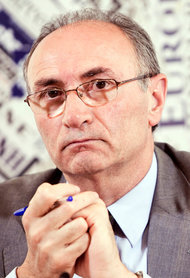And the book is voluminous, 131 pages of guidelines imposed by the American Humane Association on film and television productions, all seeking those coveted words of approval: “No animal was harmed.”
Still, animals sometimes are harmed, and when they are, the public outcry is swift. A year ago, after a third horse was injured and euthanized on the HBO series “Luck” — the horse reared, flipped over backward and struck her head on the ground — the company announced the next day that it was canceling the show.
Incidents like those on “Luck” focus attention on the humane association and its ability to monitor and enforce standards. In the aftermath of those deaths, animal rights groups pressed for answers amid suggestions of negligence, and a former association employee filed a wrongful termination suit, saying she was punished for lodging complaints about the treatment of horses.
More recently, there was a reaction over the deaths of some two dozen animals during production of the “Hobbit” films and a recent Kmart commercial on which a shark died. In a statement last Thursday, the humane association, which is based in Washington, said it was investigating the death last week of a dog that had been taken to a clinic at the association’s behest after showing signs of distress before it was called to the set of a commercial shoot.
Trainers and others in the business accuse the association of being too cozy with the industry, which provides its financing, and of being more interested in expanding its power than exercising it.
The humane association argues that it is struggling to meet the challenges of protecting animals in an era of modern filmmaking. “We’re not covering enough animal action, because of the way the business model in the industry has changed,” Robin R. Ganzert, the association’s chief executive, said in a phone interview last month.
Ms. Ganzert and others suggest that the association’s resources and authority are too limited in an era that has brought the proliferation of smaller productions — like indie films, cable TV and even Internet productions — as well as a sharp rise in public expectations regarding animal safety.
Many of these issues will get a hearing at a planned meeting on Wednesday at the Academy of Television Arts and Sciences here. So far, however, studio response has been cautious. Queried about plans to attend, no major studio except Warner Brothers confirmed that it would attend.
Film companies generally value the association’s certification, which tends to allay public concern about animal scenes, and few would suggest that the current financial shortfalls are beyond the reach of an industry that churns through billions of dollars in revenue each year. But the studios have yet to address the problem, partly because executives are wary of meddling with a financing system devised to operate at arm’s length.
Still, word of the planned get-together is provoking a fierce reaction among animal trainers and others who have not been invited (though a trainer will join a panel discussion). Some suspect the association of a power-grab that is meant to increase income, and cover its own failings.
Trainers, who are already heavily regulated by state and federal officials, are particularly incensed by the idea that the association might seek to extend its authority beyond film sets, to include certification of those who house and supply animals — something they see as an attempt to bolster funds by tapping them for fees.
“It feels to us that they’re becoming an animal rights organization no longer interested in what’s right and wrong in the industry, but only in collecting money,” said Benay Karp, an animal-keeper whose company is equipped to supply trained skunks, prairie dogs, hummingbirds or, if the scene calls for it, a rhinoceros.
In January, Ms. Karp led an uprising in which about three dozen trainers and others confronted association officials at their Studio City office. The trainers complained that the group had failed to back them in disputes with aggressive producers and directors, has often dispatched monitors who had no specific experience with exotic animals on a set, and was getting too chummy with the industry it watches.
They cited Hallmark Channel’s “2011 Hero Dog Awards,” for which Ms. Ganzert was an executive producer. Some trainers said the association had crossed a line by supplying a dog that was not specifically trained for film.
“We turned it into a listening meeting,” Karen Rosa, who oversees the association’s film and television operation, said of the showdown. “For some people, we’ll always be too tough. For others, we’ll never be tough enough.”
Article source: http://www.nytimes.com/2013/04/15/business/media/guidelines-for-animal-safety-on-film-sets-questioned.html?partner=rss&emc=rss
